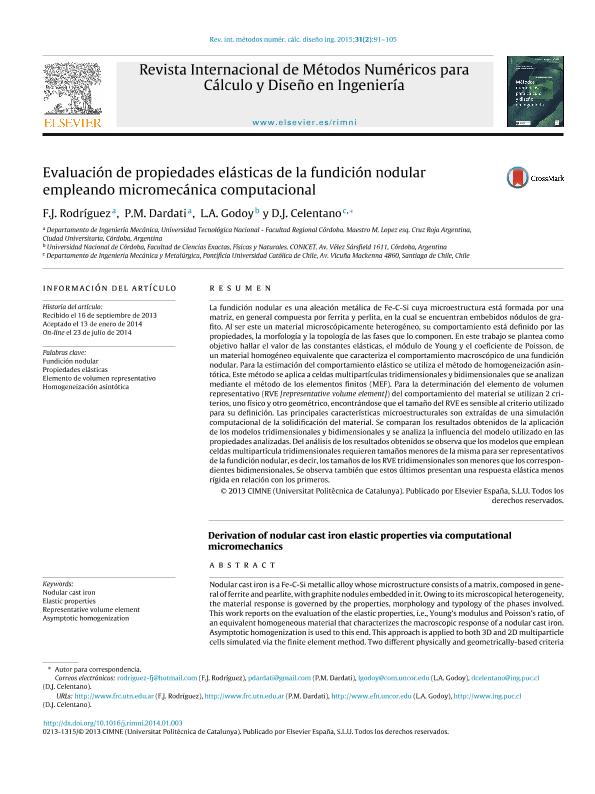Artículo
Evaluación de propiedades elásticas de la fundición nodular empleando micromecánica computacional
Título:
Derivation of nodular cast iron elastic properties via computational micromechanics
Rodríguez, Francisco Javier ; Dardati, Patricia Mónica; Godoy, Luis Augusto
; Dardati, Patricia Mónica; Godoy, Luis Augusto ; Celentano, Diego Javier
; Celentano, Diego Javier
 ; Dardati, Patricia Mónica; Godoy, Luis Augusto
; Dardati, Patricia Mónica; Godoy, Luis Augusto ; Celentano, Diego Javier
; Celentano, Diego Javier
Fecha de publicación:
04/2015
Editorial:
Univ Politecnica Catalunya
Revista:
Revista Internacional de Métodos Numéricos para Cálculo y Diseño en IngenieríÂa
ISSN:
0213-1315
Idioma:
Español
Tipo de recurso:
Artículo publicado
Clasificación temática:
Resumen
Nodular cast iron is a Fe-C-Si metallic alloy whose microstructure consists of a matrix, composed in general of ferrite and pearlite, with graphite nodules embedded in it. Owing to its microscopical heterogeneity, the material response is governed by the properties, morphology and typology of the phases involved. This work reports on the evaluation of the elastic properties, i.e., Young's modulus and Poisson's ratio, of an equivalent homogeneous material that characterizes the macroscopic response of a nodular cast iron. Asymptotic homogenization is used to this end. This approach is applied to both 3D and 2D multiparticle cells simulated via the finite element method. Two different physically and geometrically-based criteria are considered to estimate the representative volume element (RVE), where the size of the RVE is found to be sensitive to the chosen criterion. The main microstructural features are obtained from a computational simulation of the solidification process of the material. The numerical predictions computed for the 3D and 2D cases are compared and discussed in terms of the resulting elastic properties. It is observed that the models employing 3D multiparticle cells require lower RVE sizes than the corresponding 2D models, where the latter present a stiffer elastic response.
Archivos asociados
Licencia
Identificadores
Colecciones
Articulos(CCT - CORDOBA)
Articulos de CTRO.CIENTIFICO TECNOL.CONICET - CORDOBA
Articulos de CTRO.CIENTIFICO TECNOL.CONICET - CORDOBA
Citación
Rodríguez, Francisco Javier; Dardati, Patricia Mónica; Godoy, Luis Augusto; Celentano, Diego Javier; Evaluación de propiedades elásticas de la fundición nodular empleando micromecánica computacional; Univ Politecnica Catalunya; Revista Internacional de Métodos Numéricos para Cálculo y Diseño en IngenieríÂa; 31; 2; 4-2015; 91-105
Compartir
Altmétricas



